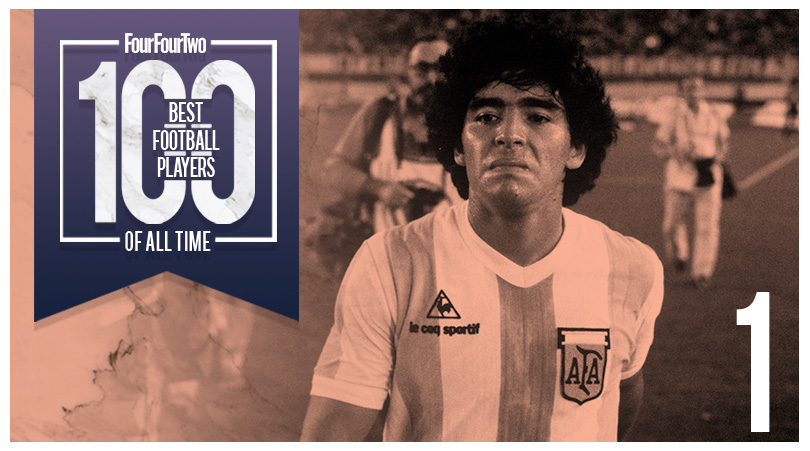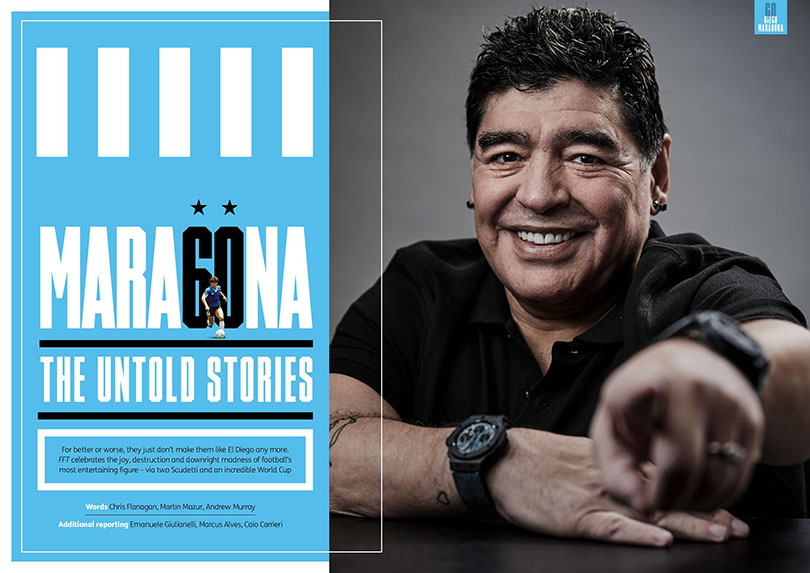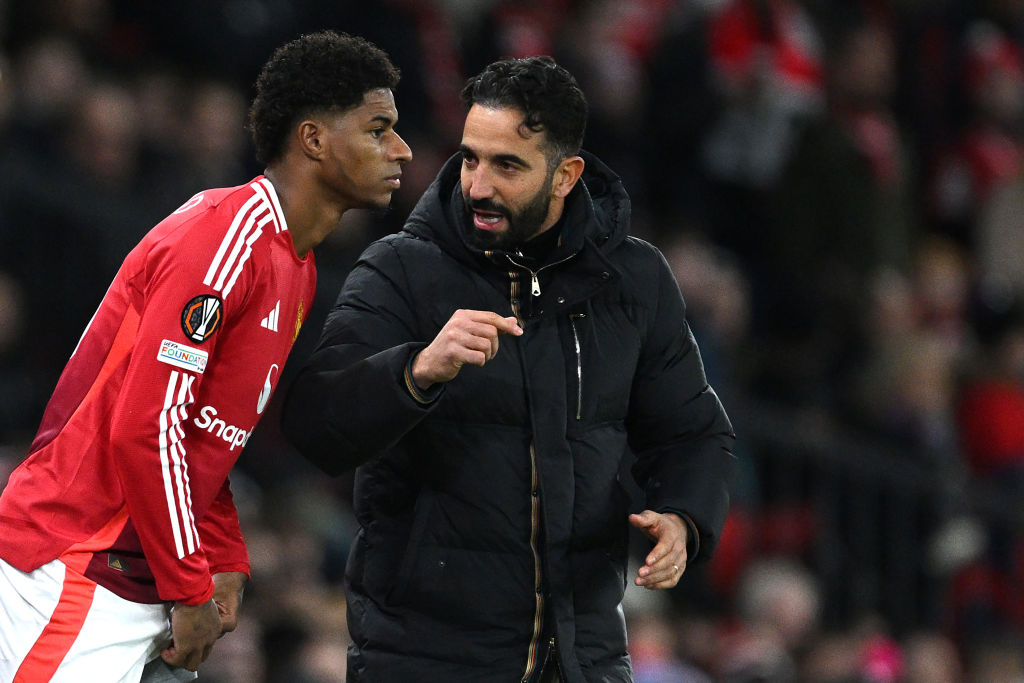FourFourTwo's 100 Greatest Footballers EVER: No.1, Diego Maradona
Diego Maradona has died, aged 60. The force of his exceptional talent and willpower bent the football world to his reality to such at extent that in 2017, we ranked him the greatest to ever play the game

Pick your favourite album of all time. Which do you choose? Thriller by Michael Jackson, because it’s shifted nearly twice as many copies (50m at the last count) as anything else? The Queen Is Dead by The Smiths because the NME told you so? Do you discount Sgt. Pepper's Lonely Hearts Club Band, Exile on Main St or Pet Sounds because the Beatles, the Rolling Stones or the Beach Boys were so strung out while writing and recording their seminal works that they barely knew their own names?
Or, do you choose the set of songs that makes you feel most alive? The album which, decades after its first spin, still demands near-constant reappraisal, regardless of the chemical enhancements associated with its creation.
Pele scored more goals. Lionel Messi has won more trophies. Both have lived more stable lives than the overweight former cocaine addict who tops this list, whose relationship with football became increasingly strained the longer his career continued. If you’ve seen Diego Maradona with a football at his feet, you’ll understand.
Kicking a ball around the Villa Florito slums, he attracted the attention of youth team Los Cebollitas’s coach Francisco Cornejo immediately.
“How old are you?” Cornejo asked the tiny Maradona.
“Eight,” came the reply. Cornejo couldn’t believe that an eight-year-old was capable of what he had just witnessed, and marched the future World Cup winner home to ask his mother Doña Tota for proof of age.
Do what you know. If you can, try a nutmeg
Poached by Argentinos Juniors, the local professional side affiliated with Los Cebollitas, Maradona made his top-flight debut on October 20, 1976, 10 days before his 16th birthday.
Get FourFourTwo Newsletter
The best features, fun and footballing quizzes, straight to your inbox every week.
“Pibe,” Argentinos boss Juan Carlos Montes told the ‘kid’ on his bench as he was about to make history as the youngest player in Argentine football, “Do what you know. If you can, try a nutmeg.”
Maradona obliged, sliding the ball through grizzled defender Juan Domingo Cabrera’s legs in a matter of minutes. His reward was a swift elbow to the chin.

Gradually, his reputation grew. “He’s a fattie who plays football very well,” said Boca Juniors keeper Hugo Gatti before an upcoming game in October 1980. “I’ll stick four past him,” responded Maradona. Argentinos won 5-2 and Maradona was true to his word, scoring a penalty, a dinked one-on-one and two brilliant free-kicks.
After winning the league with Boca Juniors, Maradona moved to Barcelona for a world-record £5m fee in 1982. It was in Catalonia that he first tried cocaine, contracted hepatitis and had his ankle broken by Andoni Goikoetxea in September 1983. The Butcher of Bilbao has the boot used in that particular assault immortalised in a glass case at home.
Maradona sought revenge in the 1984 Copa del Rey Final – headbutting one player, elbowing another and kneeing one more in the head, knocking them out cold – and was swiftly sold, for another world-record fee, to Napoli.
It was in his seven seasons in Naples that Maradona confirmed his legend. The Church of Diego Maradona still exists. The Partonopei had never come close to winning Serie A before the Argentine arrived, but such was El Diego’s individual brilliance that Napoli won Scudetti in 1987 and 1990. En route to winning the UEFA Cup in 1989, El Pibe de Oro’s (The Golden Boy) semi-final warm-up before facing Bayern Munich has long since entered football legend.
As Live Is Life by Austrian pop-rockers Opus blasts out in the Olympiastadion, Maradona’s bewildering keepy-uppy display in an ill-fitting shell suit – dancing like a hyperactive five-year-old at a wedding – is a glorious distillation of a man and his football. His boots remain untied throughout.
You’d never know his marriage to Claudia was floundering through his constant philandering. Or that his links to organised Camorra crime in Naples – and the Giuliano family in particular who had in part financed the signing in the first place – were catching up with him.
RIP Diego MaradonaA footballer you couldn’t take your eyes, even when he was just warming up pic.twitter.com/HZI3KkHBlkNovember 25, 2020
Then there’s Argentina and the 1986 World Cup. Jorge Valdano, Jorge Burruchaga and Oscar Ruggeri were fine players, but – like Napoli – it’s impossible to countenance la Albiceleste winning the tournament without their captain and magician’s five goals, five assists and general brilliance.
Ever the Machiavellian – learned the hard way on the Buenos Aires streets with what locals calls viveza criolla, or native cunning – the ends always justified the means. He knew ‘the Hand of God’ should have been ruled out – he screamed at his team-mates, “Come hug me, or the referee isn’t going to allow it” – but beating England in the quarter-final was more important.
It was impossible to score such a beautiful goal. He’s the greatest player of all time, by a long way. A genuine phenomenon
What followed was nothing short of extraordinary, as he dribbled past four English players – Peter Beardsley, Peter Reid, Terry Butcher (twice) and Terry Fenwick – to score the best goal in history after sitting Peter Shilton on his backside.
“I felt like applauding. I’d never felt that before,” said Gary Lineker, who was playing that day. “It was impossible to score such a beautiful goal. He’s the greatest player of all time, by a long way. A genuine phenomenon.”
In true anti-hero style, the controversies only serve to heighten the legend. In 1991, he went to play in a friendly organised by Pablo Escobar within the walls of the notorious drug baron’s prison. “Later that evening, we had a party with the best girls I’ve ever seen in my life. And it was in a prison!”
Maradona faded from view at Sevilla, Newell’s Old Boys and Boca Juniors, his career effectively over when he failed a drugs test for ephedrine at USA 94. Even then, he claimed that FIFA had reneged on a promise to let him take the weight-loss drug so he could play at the World Cup.
People don’t wear Che Guevara t-shirts because the Cuban Revolution led to communism becoming the world’s dominant political philosophy in the 1950s. They celebrate a flawed human being, who as a medical student became so appalled at the exploitation of South America that he resolved to overthrow governments by any means necessary.
Che Guevara lived and died by his guerrilla beliefs, polarising opinion as he went. Born 32 years later, and 310km down the Panara River from Rosario in Buenos Aires’ slums, Diego Armando Maradona did likewise, only with his feet. And, occasionally, his hands. It was little surprise when he donated the Cuban royalties of his 2002 autobiography to “the Cuban people and Fidel [Castro]”.
“Even if I played for a million years, I'd never come close to Maradona,” Lionel Messi once said. “He's the greatest there's ever been.”
Well, if Diego’s good enough for Lionel…
Career highlight
Scoring the Goal of the Century en route to World Cup glory in 1986. Mortals just shouldn’t be able to do that.
The full list
100 to 91 • 90 to 81 • 80 to 71 • 70 to 61 • 60 to 51 • 50 to 41 • 40 to 31 • 30 to 21
20 • 19 • 18 • 17 • 16 • 15 • 14 • 13 • 12 • 11 • 10 • 9 • 8 • 7 • 6 • 5 • 4 • 3 • 2 • 1
Andrew Murray is a freelance journalist, who regularly contributes to both the FourFourTwo magazine and website. Formerly a senior staff writer at FFT and a fluent Spanish speaker, he has interviewed major names such as Virgil van Dijk, Mohamed Salah, Sergio Aguero and Xavi. He was also named PPA New Consumer Journalist of the Year 2015.
